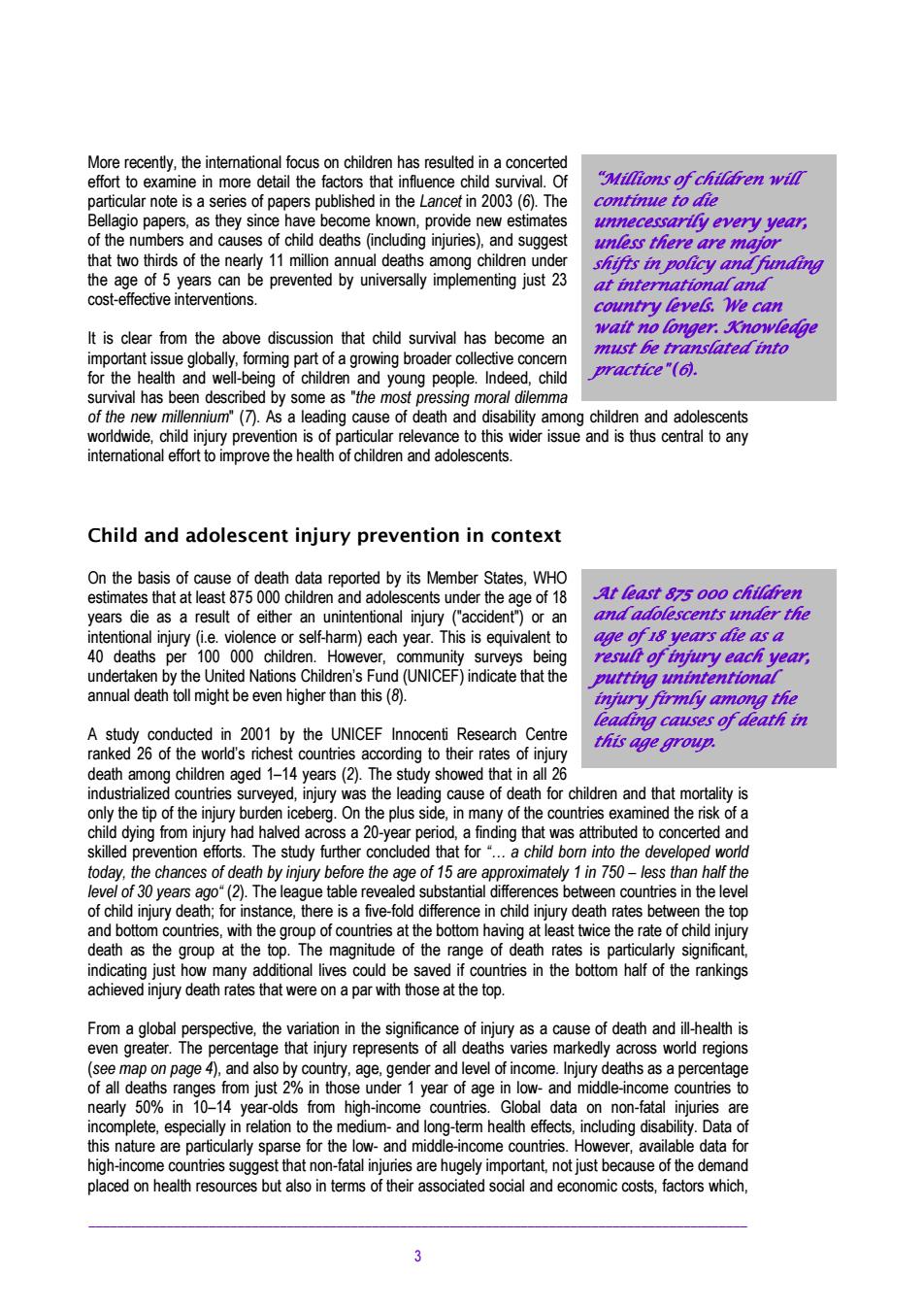正在加载图片...

More recently,the intemational focus on children has resulted in a concerted effort to examine in more detail the factors that influence child survival.Of "Millions of chilaren will particular note is a series of papers published in the Lancet in 2003(6).The continue to die Bellagio papers,as they since have become known,provide new estimates unnecessarily every year, of the numbers and causes of child deaths(including injuries),and suggest unless there are mafor that two thirds of the nearly 11 million annual deaths among children under shifts in policy and funding the age of 5 years can be prevented by universally implementing just 23 at international and cost-effective interventions. country level.We can It is clear from the above discussion that child survival has become an wait no longer.Knowledge must be franslated into important issue globally,forming part of a growing broader collective concer for the health and well-being of children and young people.Indeed,child practice"(6). survival has been described by some as "the most pressing moral dilemma of the new millennium"(7).As a leading cause of death and disability among children and adolescents worldwide,child injury prevention is of particular relevance to this wider issue and is thus central to any intemational effort to improve the health of children and adolescents. Child and adolescent injury prevention in context On the basis of cause of death data reported by its Member States,WHO estimates that at least 875 000 children and adolescents under the age of 18 At least 875 00o chilaren years die as a result of either an unintentional injury ("accident")or an and adolescents under the intentional injury (i.e.violence or self-harm)each year.This is equivalent to age of 18 years die as a 40 deaths per 100 000 children.However,community surveys being result of tnfury each year, undertaken by the United Nations Children's Fund(UNICEF)indicate that the putting unintentional annual death toll might be even higher than this(8). injury firmly among the leading causes of death in A study conducted in 2001 by the UNICEF Innocenti Research Centre ranked 26 of the world's richest countries according to their rates of injury this age group. death among children aged 1-14 years(2).The study showed that in all 26 industrialized countries surveyed,injury was the leading cause of death for children and that mortality is only the tip of the injury burden iceberg.On the plus side,in many of the countries examined the risk of a child dying from injury had halved across a 20-year period,a finding that was attributed to concerted and skilled prevention efforts.The study further concluded that for "..a child born into the developed world today,the chances of death by injury before the age of 15 are approximately 1 in 750-less than half the level of 30 years ago"(2).The league table revealed substantial differences between countries in the level of child injury death;for instance,there is a five-fold difference in child injury death rates between the top and bottom countries,with the group of countries at the bottom having at least twice the rate of child injury death as the group at the top.The magnitude of the range of death rates is particularly significant, indicating just how many additional lives could be saved if countries in the bottom half of the rankings achieved injury death rates that were on a par with those at the top. From a global perspective,the variation in the significance of injury as a cause of death and ill-health is even greater.The percentage that injury represents of all deaths varies markedly across world regions (see map on page 4),and also by country,age,gender and level of income.Injury deaths as a percentage of all deaths ranges from just 2%in those under 1 year of age in low-and middle-income countries to nearly 50%in 10-14 year-olds from high-income countries.Global data on non-fatal injuries are incomplete,especially in relation to the medium-and long-term health effects,including disability.Data of this nature are particularly sparse for the low-and middle-income countries.However,available data for high-income countries suggest that non-fatal injuries are hugely important,not just because of the demand placed on health resources but also in terms of their associated social and economic costs,factors which, 3 4 =
-
" &
5 4 !" # :
!
54 % " >
%
" >
@
@ !!" )
"
&
=
6
8 2 &
@
@!
"" %
!
" # $
*
" 2
; <
/ A B ; < >/ . B !
"!" ) 5 ; < >/ . B > 0
/
5? A
1*
!" #
5?
,
" &
-
5 %
" #
#$
%
&
'
!
( )
(
# !" #
C
%
" #
" B
%
" #
!
" >
5(
%
%
( 1*
%
%
" 9
%
%
%
" +
%
%
" 2
%
%
# $%& ' ' ' ($ " ) * " + * " , *
- .!"���������������������������������������